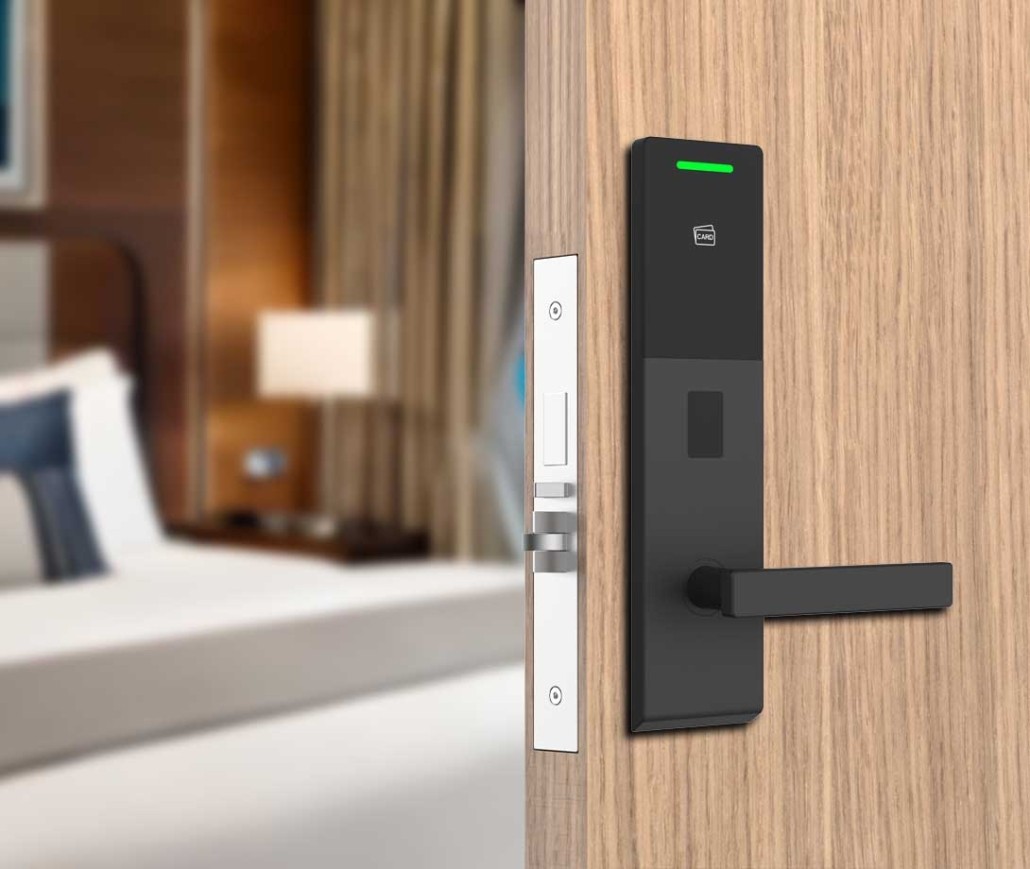How Does RFID Access Control Work?
Imagine walking into your office building without fumbling for keys or badges – just a quick wave of your card and you’re in. This seamless experience is made possible by RFID (Radio Frequency Identification) access control systems, which have become the backbone of modern security infrastructure in offices, hotels, and residential buildings worldwide.
In this comprehensive guide, we’ll break down exactly how RFID access control works, its key components, different types of systems, and why it’s become the preferred security solution for businesses and institutions globally.
Understanding RFID Technology
What is RFID?
RFID stands for Radio Frequency Identification, a wireless technology that uses electromagnetic fields to automatically identify and track tags attached to objects. Unlike barcodes that require line-of-sight scanning, RFID works through proximity, making it faster and more convenient.
The Basic Principle
At its core, RFID access control operates on a simple concept:
- A reader emits radio waves
- These waves power a passive tag (no battery needed)
- The tag responds with its unique identification number
- The system verifies this number against its database
- Access is granted or denied based on authorization
Key Components of an RFID Access Control System
1. RFID Tags (Credentials)
These come in various forms:
- Keycards/fobs (most common)
- Stickers
- Wearables (wristbands, badges)
- Smartphone emulation (NFC)
Each tag contains:
- A microchip storing unique ID data
- An antenna for wireless communication
2. RFID Readers
- Installed at entry points (doors, gates)
- Constantly emit radio signals (125kHz-2.45GHz)
- Detect and communicate with nearby tags
- Range varies from 2cm to 15m depending on type
3. Control Panel
- The “brain” of the system
- Stores authorization database
- Makes access decisions
- Can connect to network for remote management
4. Electric Lock Mechanism
- Replaces traditional locks
- Types include:
- Magnetic locks
- Electric strikes
- Motorized bolts
5. Software Management System
- Adds/removes users
- Sets access schedules
- Generates reports
- Integrates with other security systems
How RFID Access Control Works: Step-by-Step
Step 1: Tag Presentation
A user presents their RFID credential (card, fob, etc.) within the reader’s detection zone.
Step 2: Energy Transfer
The reader’s radio waves induce power in the tag’s antenna (for passive systems), activating the chip.
Step 3: Data Transmission
The tag transmits its unique identifier back to the reader via radio waves.
Step 4: Verification
The control panel checks the received ID against its authorization database.
Step 5: Access Decision
If authorized:
- Control panel triggers the electric lock to release
- Entry is granted
- Event is logged
If unauthorized:
- Door remains locked
- Security may be alerted
- Attempt is recorded
Types of RFID Access Control Systems
1. Low Frequency (LF) – 125 kHz
- Short range (2-10 cm)
- Common in older systems
- Vulnerable to cloning
2. High Frequency (HF) – 13.56 MHz
- Medium range (up to 1m)
- Supports encryption
- NFC compatible
3. Ultra High Frequency (UHF) – 860-960 MHz
- Long range (up to 15m)
- Used for vehicle access
- Faster read speeds
4. Bluetooth/NFC Hybrid Systems
- Use smartphones as credentials
- Combine RFID with mobile apps
- Offer advanced features
Security Features in Modern RFID Systems
To combat vulnerabilities, advanced RFID systems incorporate:
Encryption
- Secure communication between tag and reader
- Prevents eavesdropping/cloning
Multi-Factor Authentication
- Combines RFID with PIN or biometrics
- Significantly increases security
Dynamic Codes
- Changing credentials that can’t be copied
- Used in bank cards and high-security facilities
Anti-Tailgating Measures
- Sensors detect multiple entries
- Visual/audible alarms trigger
Advantages of RFID Access Control
For Users:
Contactless convenience
No lost keys
Quick entry/exit
Multiple credentials possible
For Administrators:
Easy to manage permissions
Detailed access logs
Remote management
Scalable for large facilities
For Security:
Difficult to duplicate
Instant credential revocation
Integration with surveillance
Customizable access levels
Common Applications
Corporate Offices
- Employee access management
- Time and attendance tracking
- Secure area protection
Hotels & Resorts
- Guest room entry
- Amenity access control
- Staff authorization
Healthcare Facilities
- Restricted area security
- Medication storage protection
- Emergency lockdowns
Educational Institutions
- Dormitory security
- Library access
- After-hours building control
Potential Limitations
1. Security Concerns
- Basic systems can be cloned
- Relay attacks possible
- Requires proper encryption
2. Implementation Costs
- Higher upfront investment
- Requires infrastructure changes
- Training needed
3. Technical Issues
- Interference possible
- Tag damage/failure
- Power dependency
Future Trends in RFID Access Control
Mobile Integration
- Smartphones replacing physical cards
- Digital wallet credentials
Cloud-Based Management
- Remote system administration
- Real-time updates
AI-Powered Analytics
- Behavioral pattern recognition
- Predictive security measures
Biometric Fusion
- RFID combined with:
- Facial recognition
- Fingerprint scanning
- Iris detection
Conclusion: The Smart Choice for Modern Security
RFID access control systems offer an optimal balance of security, convenience, and scalability that traditional lock-and-key systems can’t match. While no system is completely foolproof, modern RFID technology with proper encryption and multi-factor authentication provides robust protection for most facilities.
As the technology continues evolving with mobile integration and AI enhancements, RFID is set to remain the dominant access control solution for years to come. For organizations looking to upgrade their security infrastructure, RFID offers a future-proof solution that can grow with their needs.
Post time: May-20-2025


